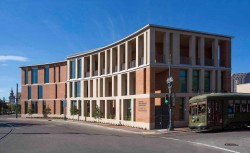Once Again, A Civic Circle
The Greater New Orleans Foundation brings new life to Lee Circle with its Center for Philanthropy, a cutting edge, 22,000-square-foot building designed by local architectural firm Waggonner & Ball.

Eighteen months and $13 million later, a corner once blighted by an abandoned Shell gas station is now home to the Greater New Orleans Foundation’s Center for Philanthropy. It is not only the “physical and symbolic home for strategic philanthropy in the Greater New Orleans region,” but a brilliant architectural sign of hope for both Lee Circle and the city’s future. “This has been an important civic space in the city for hundreds of years,” says Andy Kopplin, CEO of the Greater New Orleans Foundation. “One of the visionary things our board members did, in addition to making sure there was a home for the foundation, was seeing where they could have the greatest impact in improving the city.” Transforming an old gas station with buried contaminants like oil, lead and other chemicals, into a LEED-certified structure whose entire purpose is devoted to community service is only the start.
Local architectural firm Waggonner & Ball was tapped to design the new Center for Philanthropy and it was with great excitement and anticipation that they took up the task. “Having the opportunity to build [in Lee Circle] is something I’ve wanted my whole life,” says F. Macnaughton Ball, partner at Waggonner & Ball Architects. “But I never thought we’d get to do a civic building with such importance like the Center for Philanthropy for the Greater New Orleans Foundation.”
Ball’s great respect for the organization was instrumental in the design, encouraging him to create a building that would reflect the values of the foundation. Using the classic Doric column that supports Lee’s statue as inspiration, Ball created a network of vertical sticks of light-colored, cast stone in order to reinforce the “feel” of a civic presence. The firm also used a local material, St. Joe’s Brick made in Slidell, which offers an orange color to contrast the stone. “We didn’t want it to be classical in the sense of power, but more classically influenced in the sense of enlightenment,” Ball says.
Again echoing classic Roman civic structures, the gentle ramp that brings people to the front door holds great symbolic importance for both the city and the foundation beyond its utilitarian purpose as an entryway. “It’s important for the Greater New Orleans Foundation as a message that all people, even those who are disabled and need a wheelchair, can come up and use the front door,” Ball says. The back side of the building, the side that faces due north toward downtown, is a three-story, glass curtain wall. Passersby can look straight into the Chevron Learning Center, a public space that can hold up to 211 people, giving it an inclusive feeling as well as one of transparency, which are both core values held by the Greater New Orleans Foundation.
One of the most hopeful aspects of the Center for Philanthropy would have to be its “green” infrastructure. Waggonner & Ball has long been an avid proponent for the survival of this historic city, especially after the tragic levee failures of 2005. With extensive studies and input from Dutch engineers, the firm published Living With Water: A New Vision for Delta Cities wherein the Greater New Orleans Urban Water Plan was established as a way our city can implement sustainable water-management strategies. In developing the Center for Philanthropy, the architectural firm included a plan for stormwater management, so the building can collect and store water that falls onto the roof and re-channel it to irrigate the gum trees and other greenery on the property. The parking lot is made with permeable asphalt, allowing the property to absorb as much as seven inches of rainfall — thereby lessening the burden on the city’s drains.
Finally, in a gesture that exceeds its ornamental semblance, the Center for Philanthropy also features an exquisite collection of local art curated by Arthur Roger, a Greater New Orleans Organization board member and the owner of Arthur Roger Gallery on Julia Street. Select pieces from the Ogden Museum of Southern Art, Amistad Research Center and, of course, the Arthur Roger Gallery now adorn the walls and meeting rooms of the new building. “Lo and behold, Arthur Roger brings over a John Scott that has been in a warehouse for the last 10 years and put it on the third floor as you get off the elevator,” Ball says. “It’s a fascinating group-effort piece of art, which is what the Greater New Orleans Foundation is … people working together to make something beautiful happen.” gnof.org wbarchitects.com
